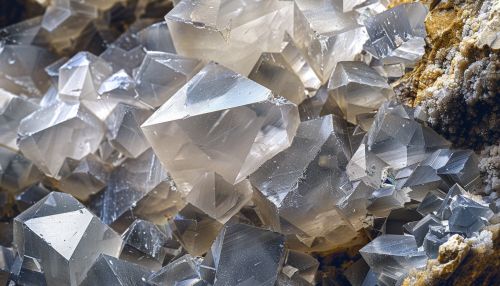Carbonate Chemistry
Introduction
Carbonate chemistry is a branch of chemistry that deals with the study of carbonate (CO₃²⁻) and bicarbonate (HCO₃⁻) ions, their properties, reactions, and roles in various natural and industrial processes. This field encompasses a wide range of topics, including the behavior of carbonate compounds in aqueous solutions, their interactions with other chemical species, and their significance in geological and biological systems.
Carbonate Ions and Compounds
Carbonate ions (CO₃²⁻) are polyatomic ions consisting of one carbon atom covalently bonded to three oxygen atoms, forming a trigonal planar structure. Carbonates are salts or esters of carbonic acid (H₂CO₃), and they are commonly found in minerals, rocks, and biological systems. Bicarbonate ions (HCO₃⁻) are the conjugate base of carbonic acid and play a crucial role in maintaining pH balance in natural waters and biological fluids.
Common Carbonate Minerals
Carbonate minerals are abundant in the Earth's crust and include some of the most well-known minerals such as calcite (CaCO₃), aragonite (CaCO₃), and dolomite (CaMg(CO₃)₂). These minerals are essential components of sedimentary rocks like limestone and marble. They form through various geological processes, including precipitation from aqueous solutions and biological activity.


Industrial Applications
Carbonate compounds have numerous industrial applications. Sodium carbonate (Na₂CO₃), also known as soda ash, is used in glass manufacturing, water softening, and as a cleaning agent. Calcium carbonate (CaCO₃) is used as a filler in paper, plastics, and paints, and as a dietary calcium supplement. The versatility of carbonate compounds makes them valuable in various industrial processes.
Aqueous Carbonate Chemistry
The behavior of carbonate and bicarbonate ions in aqueous solutions is governed by a series of equilibrium reactions involving carbon dioxide (CO₂), water (H₂O), carbonic acid (H₂CO₃), bicarbonate (HCO₃⁻), and carbonate (CO₃²⁻). These equilibria are crucial for understanding the chemistry of natural waters, including oceans, rivers, and groundwater.
Carbonate Equilibria
The primary equilibria in aqueous carbonate systems are: 1. Dissolution of carbon dioxide in water:
CO₂(g) + H₂O ⇌ H₂CO₃(aq)
2. Dissociation of carbonic acid:
H₂CO₃ ⇌ H⁺ + HCO₃⁻
3. Further dissociation of bicarbonate:
HCO₃⁻ ⇌ H⁺ + CO₃²⁻
These equilibria are pH-dependent and play a significant role in buffering the pH of natural waters. The Henderson-Hasselbalch equation is often used to describe the pH of bicarbonate-buffered solutions.
Geological Significance
Carbonate chemistry is integral to various geological processes, including the formation of sedimentary rocks, the carbon cycle, and the sequestration of carbon dioxide.
Sedimentary Rock Formation
Carbonate minerals precipitate from aqueous solutions to form sedimentary rocks. This process can occur through abiotic means, such as the evaporation of seawater, or through biotic means, such as the accumulation of shell fragments from marine organisms. Over geological timescales, these processes contribute to the formation of extensive limestone and dolomite deposits.
The Carbon Cycle
The carbon cycle involves the exchange of carbon among the atmosphere, hydrosphere, biosphere, and geosphere. Carbonate chemistry plays a pivotal role in this cycle, particularly in the sequestration of atmospheric CO₂ in the form of carbonate minerals. Weathering of silicate rocks also contributes to the long-term removal of CO₂ from the atmosphere, forming bicarbonate ions that are eventually precipitated as carbonate minerals.
Biological Importance
Carbonate and bicarbonate ions are vital for various biological processes, including respiration, calcification, and pH regulation.
Respiration and pH Regulation
In biological systems, bicarbonate ions serve as a buffer to maintain blood pH within a narrow range. The enzyme carbonic anhydrase catalyzes the interconversion of CO₂ and H₂CO₃, facilitating the transport of CO₂ from tissues to the lungs for exhalation. This buffering system is essential for maintaining homeostasis in living organisms.
Calcification
Marine organisms, such as corals, mollusks, and some algae, use carbonate ions to form calcium carbonate shells and skeletons. This process, known as calcification, is crucial for the growth and structural integrity of these organisms. Ocean acidification, resulting from increased atmospheric CO₂, poses a threat to calcifying organisms by reducing the availability of carbonate ions in seawater.
Environmental Impact
Carbonate chemistry has significant implications for environmental science, particularly in the context of climate change and ocean acidification.
Ocean Acidification
The absorption of anthropogenic CO₂ by the oceans leads to the formation of carbonic acid, which dissociates to release hydrogen ions, thereby lowering the pH of seawater. This process, known as ocean acidification, reduces the concentration of carbonate ions, making it more difficult for marine organisms to form calcium carbonate structures. Ocean acidification is a major concern for marine ecosystems and biodiversity.
Carbon Sequestration
Carbonate chemistry is also relevant to strategies for mitigating climate change through carbon sequestration. One approach involves the injection of CO₂ into deep geological formations, where it reacts with minerals to form stable carbonate compounds. This process, known as mineral carbonation, has the potential to permanently sequester large amounts of CO₂.
Analytical Techniques
Various analytical techniques are used to study carbonate chemistry, including titration, spectroscopy, and chromatography.
Titration
Acid-base titration is a common method for determining the concentration of carbonate and bicarbonate ions in a solution. The titration involves the addition of a strong acid to the sample, and the endpoint is detected using a pH indicator or a pH meter. The titration curve provides information about the buffering capacity and the relative concentrations of carbonate species.
Spectroscopy
Spectroscopic techniques, such as infrared (IR) spectroscopy and nuclear magnetic resonance (NMR) spectroscopy, are used to study the molecular structure and dynamics of carbonate compounds. IR spectroscopy can identify characteristic vibrational modes of carbonate ions, while NMR spectroscopy provides information about the chemical environment and interactions of carbonate species.
Chromatography
Ion chromatography is used to separate and quantify carbonate and bicarbonate ions in complex mixtures. This technique involves passing the sample through a column packed with an ion-exchange resin, which selectively retains the ions based on their charge and size. The separated ions are then detected using a conductivity detector or a mass spectrometer.
